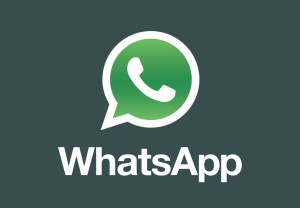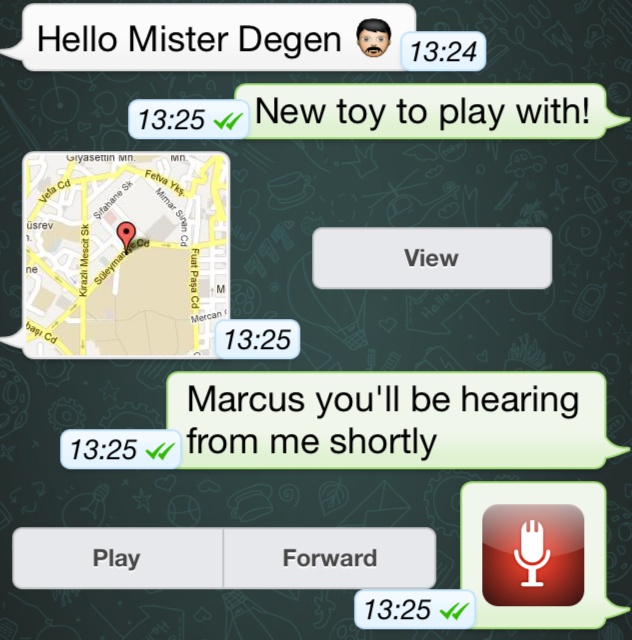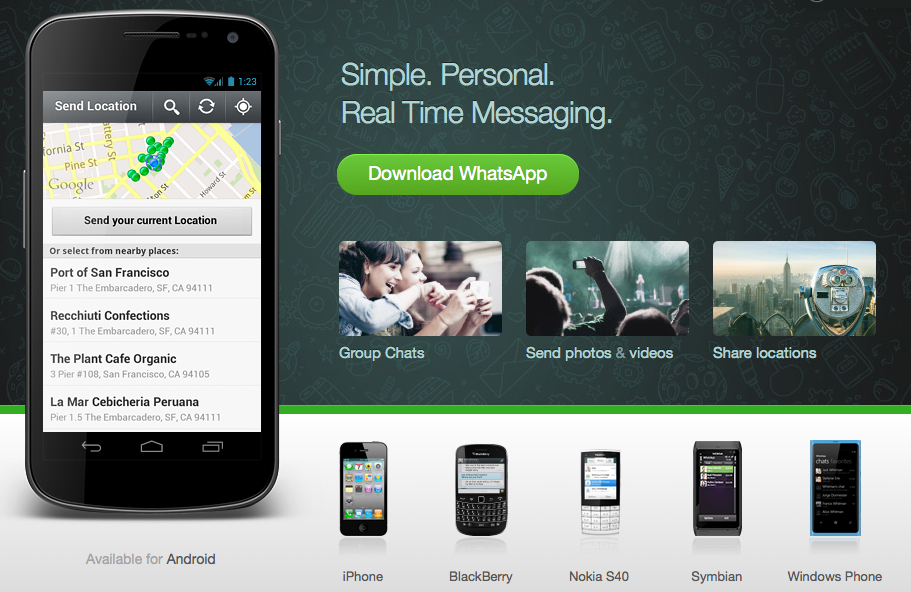Using WhatsApp for multimedia and mobile journalism training
Be creative, experiment and learn through play.
This is something I’m always trying to encourage participants to do during any workshop. But particularly when it comes to learning about multimedia, or using a mobile phone for reporting, and getting used to new types of media for storytelling.
So what’s up with using the mobile messaging service WhatsApp as a tool to complement training in workshops? Well, potentially a lot… particularly for practical exercises. But first, if you haven’t yet dialled into the world of WhatsApp, here’s a quick overview.
More than just SMS
In short, WhatsApp is a mobile multimedia messaging application.
You can use WhatsApp to send text, photos, audio and video, as well as your map location. WhatsApp encrypts messages. It’s also a cross-platform application meaning that it works on iPhone, Android, Windows, Blackberry and Nokia (Symbian) mobile phones – a good thing for training workshops where it’s BYOD – bring your own device.
The application uses mobile data networks to exchange messages. So, if you have a good mobile phone plan for web browsing, WhatsApp is very attractive because you can avoid paying for text messages or multimedia messages.
Depending on where you are training, you might find that all of your participants are already addicted to WhatsApp. Moreover, given that it’s an app that works across different types of phones, there’s a good chance that most of your participants will be able to download and install it.
 Mobile journalism guru Marcus Boesch first introduced me to WhatsApp while we were training in Turkey. With a local data SIM card it seemed like the perfect app for staying in touch with friends and family. Not only could I send text messages and photos, but it was also a fun way to send little audio or video messages. Straight away I was learning to use the app by playing.
Mobile journalism guru Marcus Boesch first introduced me to WhatsApp while we were training in Turkey. With a local data SIM card it seemed like the perfect app for staying in touch with friends and family. Not only could I send text messages and photos, but it was also a fun way to send little audio or video messages. Straight away I was learning to use the app by playing.
If you’re still wondering about what all the fuss is about messaging applications such as WhatsApp, it’s a very competitive market. Facebook has recently opened its Messenger app on iOS and Android phones to non-Facebook users in select countries. Like WhatsApp all you need is a phone and a number and Messenger also lets you send audio messages. And Skype has just released a new version (only for Mac + iOS) allowing users to send short video messages within Skype IM chats.
And if these figures are anything to go by, WhatsApp had quite a busy day on New Year’s Eve.
Getting started
Once installed, it’s pretty simple – and that’s what we like for workshops. There’s no account registration or log in. All you have to do is verify your phone number with the service. But do give some thought as to when you ask participants to install the app. Installing apps and troubleshooting can be a huge thief of time during workshops. If your workshop involves participants bringing their own devices, I find it’s always better for them to try and install all apps before the course. Or, depending on how long your course is, set aside some dedicated time to trouble shoot. Someone’s phone will always have problems whether it’s with hardware or firmware.
When you launch WhatsApp you can check through your phone contacts to see who is already using the app. You then click on a contact name and send them a message. You can also send non-users an invite to install the app. But keep in mind that WhatsApp has run into some problems on this function with regulators over privacy and storing of information. Dutch and Canadian data protection authorities are concerned that WhatsApp keeps phone numbers of non-users: even though the numbers are stored in a hashed or anonymous format. It would be worth monitoring how WhatsApp resolves this problem.
Costs
At the moment for the iPhone, WhatsApp costs a one-off purchase fee of US$0.99 when you purchase through iTunes – this may change. For other phones, it’s free to download and use for a year. After that, you’ll have to purchase the app.
For many of our journalist participants, airtime and mobile data are very precious necessities for both work and home. Airtime expenses are often not reimbursed by their employer. But for short courses, providing airtime/data for participants is something that can budgeted for.
So what can you produce with WhatsApp?
Text
Simple. But unlike an SMS, you’re not limited to 160 characters. And yes, you can also add emoticons 🙂 .
Photo or video
There is the option to either take a photo or record video directly when you’re producing the message, or choose an existing image or video from your phone’s album – that means you produce an image or video on another app and share via WhatsApp. Unfortunately you can’t include text in a photo message. You can also forward an image or video to another WhatsApp user or someone else via email.
Audio
When you select the Audio Note option a red Record button appears. You can record up to 2 minutes of audio.
Location
When you select this option, a map appears pin-pointing your location. If this is not accurate enough, you can either directly enter your address into the search bar, or select a nearby location from the list. On my iPhone the location service is powered by foursquare. For some reason you can not forward a location message.
Send a message to a group
Group chat is one of the functions that makes WhatsApp interesting for journalists. You can add up to 30 contacts for a group chat.
For training, a specific group could be established for participants and trainers during the workshop to exchange multimedia content. Small newsrooms might also find good uses for group messages. In Israel, the government and police services are using @WhatsApp groups to communicate with journalists working specific beats. In India, during the recent Kumbh Mela, Indian police use WhatsApp to share information on lost & found people.
Email entire conversation as a .txt document
Not quite an obvious function. But this might be useful for archiving conversations (including all of the media exchanged) for research. Or, perhaps you’ve conducted a text or multimedia interview with someone, you could email the entire conversation to yourself and publish the material on another platform.
Using WhatsApp as a training tool
Getting participants excited about using new types of media and social media – that’s the key. WhatsApp is not going to be the primary tool they’ll use for newsgathering, but it’s a great way of encouraging them to produce and share simple multimedia elements. I always think if it’s fun to do then participants will keep on practicing skills that they learn in the workshop.
Ideas for practical exercises
Multimedia street safari
Working in pairs or in small groups, participants can find an interesting street or market and document what they see and hear. They can take photos, make short video clips, record interesting sounds or produce short interviews. They can send materials to each other, or to the trainers who will be able to see what they are producing straightaway and send feedback on the spot.
Explore a specific theme
If you set up a group for your participants on WhatsApp you could get everyone sharing content with each other on a specific theme – maybe public transport, or street vendors or local food? It be could be anything. Brainstorm ideas with your participants. This could even be a fun little exercise that everyone does everyday after the workshop.
Multimedia interviews
A slightly different type of interview. Participants could interview each other via WhatsApp. For instance about their media outlet and their day to day work as journalists. Questions and answers could be exchanged in different forms of media: text, audio or video. And consider this: depending on the recording quality of a phone, the Audio Note function of WhatsApp might also help radio news journalists looking for a quick soundbite from an interview partner.
WhatsApp is just one of a number of cross platform tools you could use in training to encourage participants to produce and share simple multimedia elements with their mobile phones – social media or blogging platforms such as Twitter, Facebook or Tumblr are obvious ones too (and I’d like to see Twitter added as a message forwarding option to WhatsApp). But given the growth of messaging applications, and the possibility of simply exchanging messages between participants makes, it an interesting tool to explore for training.
Are you using WhatsApp in an innovative way? Or is it a tool you are using for journalism or journalism trainng? We would really like to know how you might be using the app.
Author: Guy Degen







Feedback